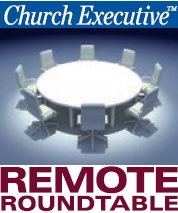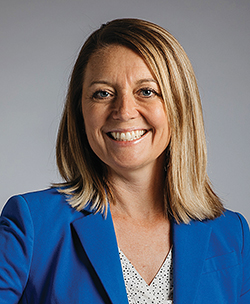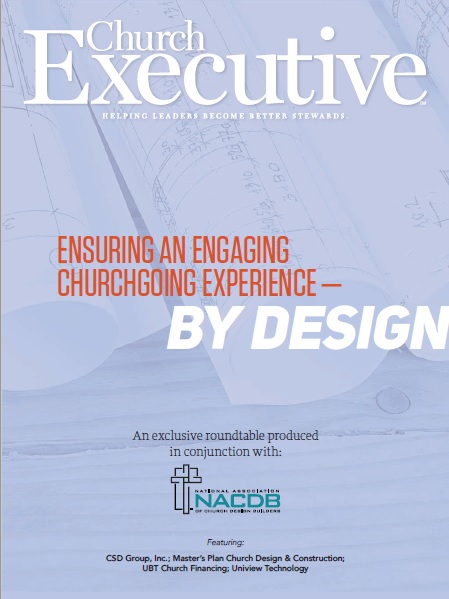 An exclusive roundtable produced in conjunction with the National Association of Church Design Builders.
An exclusive roundtable produced in conjunction with the National Association of Church Design Builders.
 Roundtable participants are members of this non-profit organization that serves as a resource for the planning, design and construction of churches and church-related facilities.
Roundtable participants are members of this non-profit organization that serves as a resource for the planning, design and construction of churches and church-related facilities.
The goal of NACDB is to educate local churches on how to go about designing, building or remodeling their facilities.
Ensuring an engaging churchgoing experience requires thoughtful facility design, of course. But, considerations around worship technology, security and surveillance, and even financing are also crucial.

Executive Pastor
Grace Community Church (Bartlesville, Oklahoma)
The picture of what an engaging church looks like has certainly changed over the years. What key characteristics do engaging churches share, today?
Kuehn: I’ve worked with churches of all shapes and sizes. From my perspective, the most engaging churches today are the ones who meet their people where they are. The churches who find their way into people’s daily lives — not just Sunday mornings — are the ones who are growing. Their leadership teams include people from all disciplines, not just ministry, to bring balance to their growth, as well.
Fredericks: In the most engaging churches, a feeling of family and sense of belonging are very important. People want sermons that are relevant to where people are at in life today.
Hood: They’re secure in knowing who they are. They’ve found their personal balance between structure and freedom. Churches today can connect in ways we couldn’t even dream up just a few years ago — and that’s a good thing! But, adding solid technical connections while maintaining a freedom for the Holy Spirit to move freely can be quite a challenge.

Lead Pastor
Grace Family Church
(Newtown, Connecticut)
For example, not too long ago, if I was leading a service that had more of a free flow to it, I would just print out a bunch of chord charts, have them on the music stand, and flip through them to whatever song I needed. I would start to play a few bars, and the band could pick up where I was going and follow along.
If I were to lead that same service today, different thoughts run through my mind. Now, if I want to make a song change, these real thoughts race through my mind in a matter of microseconds:
- Do we have the lyrics loaded into the graphics computer? If not, will the vocalists know the words?
- Will this song gel with the lighting cues already planned?
- Where’s my phone? Can I text the front-of-house engineer?
- Will the broadcast and camera team get the message?
- Will this throw off the ushers to come up for the offering?
- Does the bass guitarist have a printed-off sheet of this?
- Does the acoustic guitar need to capo?
- I don’t have a click track. Will the drummer be OK?

President, CSD Group, Inc.
Certified Church Consultant, NACDB
Author, Worship Unicorn
Worship Pastor, Central Ministries
In fairness, some tools give the worship leader more freedom in going back and repeating a chorus (for example), but we still face limitations to abandoning the plans for the day and doing something different.
We must establish a balance between technical and musical excellence and the freedom to follow God’s prompting. If we take the time and invest in specific efforts that will work for our congregation, we can find that balance. It will look different for each of us, so we have to devote ourselves to taking the time to pray and seek God out in these matters. God’s prerequisites for worship might be different than ours. But if we ask for wisdom in this area, He will give it.
James: Engaging churches today provide space and opportunity for connection and relationships. Our culture thrives on relationships, and relationships require the ability to be connected to others.
From a facility perspective, it means designing gathering spaces that allow people to feel comfortable, to have space to have intimate conversations, to feel welcome and not rushed. When we speak with church attenders and ask about what they like in a church facility, we hear words like “warm,” welcoming,” “safe,” “comfortable,” “family-friendly” and “inviting.” People are engaged when they sense these feelings within our churches.

President
Master’s Plan Church Design
and Construction
A truly engaging worship experience also requires connection. Attenders want to feel connected to the experience and the people leading them in worship. Sanctuary design changed dramatically over the past three decades. The main driving force is that people want to feel a personal connection to the lead worshipers on the platform. They want to sense the sermon is more of a personal communication — almost a conversation, even — rather than a speech or teaching session.
Technology helps us with this through magnification, but the shape of the room, the volume of the room, the intimacy of the room, and the sight lines are all critical elements in design that help “engage” those in the audience.
Conrad: The topic of engagement was critical to our conversation with Rodney [James] and his team at Master’s Plan. The theme of our campaign is “Transforming the Next Generation,” because our desire is to engage our church community by creating a space where transformational discipleship can take place at all levels. Rodney and his team have coached our staff through the process of developing not just a floor plan, but also a way of using our building to become more effective in the way we conduct ministry. It’s clear to me that the intention is to create areas of ministry that engage our people in the culture that already exists.
Do engaging design strategies differ between age groups?

President, Emanate Consulting
Vice President,
UBT Church Financing
Fredericks: Yes; studies have shown that younger families are looking for a more modern feel in their churches but still want some traditional elements — stained glass, crosses, and so on. The sanctuaries also need to have adequate sound and media equipment.
James: McDonalds led the way to help churches learn how to engage children. The brilliance of the chain’s first playgrounds increased their traffic by more than 60 percent.
It took longer for churches to catch on; but when they did, they took it to the extreme. They wanted to engage kids — and wanted kids to want to engage — so children’s spaces went from white block walls in the basement to fully themed, colorful and inviting spaces that were attractive to children and, therefore, attractive to families. Kids today often have cell phones in their hands at age 2 or 3, so churches have been challenged to design technology that engages the kids as they learn. Designing engaging children’s space is fun and challenging, especially when we’re trying to maximize dollars in a project budget.
Engaging students (youth) means creating space that they can recognize as “their space.” Too often, student ministry gets leftover or shared space — and especially the leftover furniture! This is tragic, because it clearly communicates to the church of tomorrow that they’re not valued (especially if they come from a newly renovated children’s area). Engaging youth spaces

VP Sales, Uniview Technology (uniview tec)
Certified Church Consultant,
NACDB
have a vibe, feel, and communicate an ethos that they belong, they’re valued, and that they’re a part of the church’s culture. These spaces also must be technologically up to date and allow space for fun, as well as learning.
While many senior adults love that their church is reaching young families and growing the Kingdom, they’re often the most left-out group when it comes to engaging churchgoers. Church building teams must be cautious not to engage only young people to provide vision and direction for future facility modifications, because they don’t often consider the needs of seniors. Things that matter are proximity from their space to parking and from their space to the sanctuary, as well as proper lighting and access for walkers, wheelchairs and motorized chairs.
An engaging churchgoing experience starts the moment an individual steps foot on campus. To that end, which engagement strategies do churches most often overlook?
Hood: Perimeter areas are too often ignored or underdeveloped. You’re right that a person’s experience starts as soon as they step foot on campus. From an AV perspective, in some cases, there’s no connection until the person walks through the auditorium doors.
People who’ve attended your church their whole lives forget what it’s like for a new person. For example, if someone steps foot in the lobby and it’s dead quiet, that can feel weird, like a hospital or a library — which is probably not the impression you want first-time guests to have.
This is why background music can be so effective. It gives some ambient “noise” that feels much more natural as people move throughout your space.
The video experience is just as important. From a visitor’s perspective, the use of digital signage can be a big boost to making a first-time guest feel more comfortable. First, it gives them something visually interesting to look at. It might have some announcements for the day, or a map of the campus, or a list of classrooms. Or, for those who arrive late — not that this ever happens in church! — it could have a live camera feed from the worship center so they can be drawn into the worship experience. Proper audio and video perimeter systems can make a real connection to the main worship space. They can also make an earlier connection and reach out further to start to communicate to a first-time guest as soon as he or she steps out of the car.

Shaver: From a security point of view, let me add some thoughts as this emerging characteristic is growing in importance. The use of security cameras in the design illustrates that safety is important for church staff, members, visitors and guests.
As a simple example, the use of visible cameras beginning in the parking lots and church building entrances ensures all that their safety and security are important to the church. Continuing the video security through-out the facility — such as the nursery and children’s areas — certainly can provide a level of comfort for young parents.
For the church leaders in our discussion: In what ways does your church’s design support engagement, campus-wide?
Conrad: The design of our new building will engage our members in three specific ways.
First, it will create a gathering and hospitality area that will be used by the entire community throughout the week for fellowship and discipleship. This area will also aid in the building of unity among our Sunday worshippers before and after the services.
Next, the children’s area will provide a safe environment for kids to learn about God and His Word, which will allow parents to feel comfortable leaving their children while they worship and learn in the service and studies throughout the week.
Finally, the student area will be the first of its kind for our church. This will be an area where leaders can come alongside students in opportunities for fellowship and discipleship.
All three of these areas will give us the space and security needed to provide opportunities for transformation through Jesus Christ.
Is demonstrating engagement important to the church financing process?
Kuehn: Yes. A church with an “engaged” church family is growing in both numbers and in finances. This means that each year, the church is seeing its annual contributions grow at least a small percentage. Church members typically become engaged before they start to give consistently. Once you start seeing the average annual gift per member tick up, that’s a good indicator.
The same goes for new attendees. It typically takes people 12 to 18 months before they feel like they’re part of a church family.
From a lending perspective, engagement goes beyond just the worship service — it can be seen in the leadership team, in the quality of the financial statements a church provides, and in the way a church presents itself to a lender. Leadership teams who are well-rounded in both business and ministry are often the most successful in securing a lending relationship. Churches need a leader with vision, but they also need people on the team who can get things done, who will follow through, and who understand business. These people don’t need to be paid staff; they can be on the board or simply volunteers within the church.
The most critical part of providing financial information to a bank or financing company is to provide information in a format that’s widely acceptable in the business world. I always recommend that any church looking for financing has a CPA take their information and put it in a “Compiled” statement, at minimum. This is the lowest-statement quality provided by a CPA; but to a lender, it says that a professional has looked at the numbers and that they balance year over year. It also shows that you’re serious about taking your church to the next level, financially.
Larger loans should be providing a “CPA-Reviewed” statement to their prospective lenders.
Fredericks: Yes, demonstrating engagement has been important to the financing process at our church. We wanted the entire congregation to be involved in giving, regardless of the amount. We ran several projects that enabled people to choose how they wanted to be involved.
In what ways can engagement be gauged and demonstrated to a lender?
Kuehn: So many churches that I’ve worked with over the years provide information in a format that makes sense to them, but not to a lender.
There are several key ratios that lenders will look at right up front to see if your church will meet the criteria set by their underwriting policy. A leader who not only knows what a lender will be looking for, but has prepared his or her church to meet the criteria lenders need, will make the underwriting process smooth for the church and the lender.
For this reason, it can be very worthwhile to enlist someone who understands both the church’s needs and the financing institution’s needs early in the lending process to ensure your success in getting a loan offer that not only satisfies your church’s financing needs, but is also competitive in the market. Asking the right questions of a church consultant is critical:
- What experience do you have with working with churches on their finances?
- Can you provide a few references?
- Does your organization actually fund the loan?
- If not, what lenders do you work with to fund? Do you understand what criteria they use for approvals?
- How will you help us present our information in a way that a bank will find appealing?
- What financial guidance can you provide us?
- Are you willing to come meet us in person?
- Do you offer construction funding oversight?
- What’s the upfront cost of your services? What costs are there when you find us a loan?
Fredericks: In terms of engagement, UBT Church Financing was incredibly friendly and helpful towards us. Regular phone calls and updates from us to the lender kept them involved.
Sending photos of the building as it was constructed, as well as video updates, also helped keep them engaged.
An engaging experience means that members, guests and visitors feel welcome on campus all week long. How can this be achieved?
James: All ministry facilities should be designed for more than a few-hours-per-week experience. Facilities should be multi-use and multipurpose, allowing the space to be used in various ways.
Knowing that people today desire that feeling of being connected, it’s critical to create space where people can meet, connect, and share life throughout the week if we want to engage our culture today. Coffee shops, gathering spaces — even children’s play spaces — can all engage people throughout the week when they’re designed correctly and placed strategically in the facility and on the campus.
Fredericks: Bright, clean buildings speak volumes.
Also, from an AV perspective, at our church, platform projection, a lobby display TV, and colored lighting for the stage are helpful for engagement. We enlisted an AV company early on in the design to ensure sound quality for the room. They had the largest say in how we designed our facility. If people can’t see or hear, then you’ve built this space for nothing.
In what ways can security and surveillance technology contribute to an engaging churchgoer experience?
Shaver: To ensure a positive, engaging experience for all age groups, safety and a peace of mind must be considered and provided.
In terms of design, necessary steps are required to ensure the proper infrastructure is in place for security. This includes equipment rooms and wire chases — large conduits strategically placed in your walls where large numbers of cables gather and run together for short distances.
The design strategy must incorporate a campus-wide security solution. Your church must provide a level of security that ensures parents of young children — as well as families and senior adults — experience a safe, secure and friendly environment.
Because a churchgoer’s first experience on your campus begins upon arrival, consider the use of outdoor cameras monitoring the driveway entrances and parking lots. This clearly illustrates that safety is important to your church.
The experience continues with a reassurance of security, including video cameras to monitor and document the facility perimeter — facility entrances and outdoor play areas, for example.
Within the facility, cameras should monitor nurseries, children’s ministry spaces, classrooms, indoor play spaces, and common family areas. For parents of young children, in particular, knowing that people moving in and out of these areas (and are even recorded) provides much-needed peace of mind.
While all egress points leading into and out of the facilities and children’s areas should be monitored, the same applies to coverage in senior adult areas. This means monitoring drop-off points, elevators, and the areas outside of restrooms, where seniors might be susceptible to slip-and-fall accidents.
Adequate video coverage is necessary within shared spaces, as well — in worship areas, sports facilities, large hallways or coffee shops, for example. Cameras in these spaces can help church leaders keep an eye on (and document) all activities.
Though it might seem counterintuitive, I feel this is important to say: cameras in your church should be seen, not hidden or covert. Video cameras installed in and around the church facility enhance the deterrent value to persons who want to cause harm to your attenders or facilities.
Fredericks: I agree; security and surveillance technologies help people feel comfortable when their children are in classrooms away from them. It also creates a sense of calm, knowing that there are people looking out for their children’s well-being.
Which security and surveillance technologies are on the “wish list” for most churchgoers?
Shaver: First, an alarm system — typically, a burglar alarm. This provides 24-hour protection for office staff arriving early or working late. It also provides off-hours monitoring for possible facility-entry attempts. The burglar alarm is a monitored system and will contact local law enforcement when an incident occurs.
The second tool should be video security. This will provide a view of the scene of interest within the camera’s field of view for live monitoring. Most importantly, it maintains video documentation of activities for later review. The use of video cameras ensure security in classrooms and hallways and provides a peace of mind to church members, guests and visitors.
Finally, churchgoers like to see facility access control. The access control component lets the church lock and unlock perimeter doors for worship and study activities on a predefined schedule. Critically, this allows access into children’s areas and all egress points leading into the facilities only to those persons with the proper credentials. Access control ensures that church members, visitors and their children are protected during service times and during off-hours.
— Reporting by RaeAnn Slaybaugh


